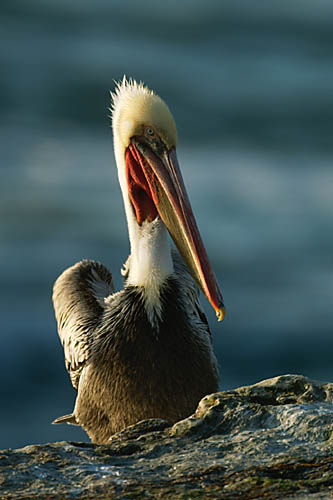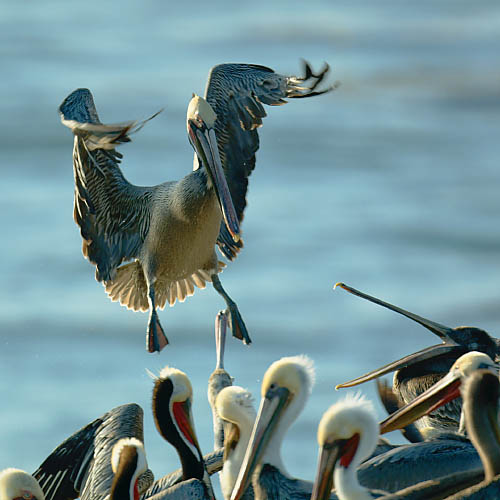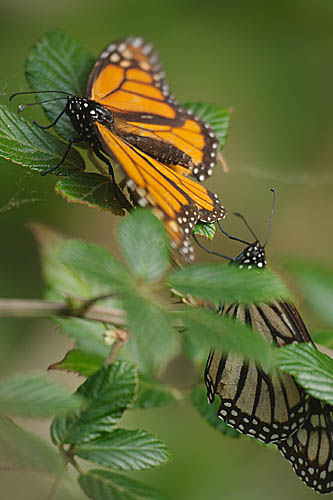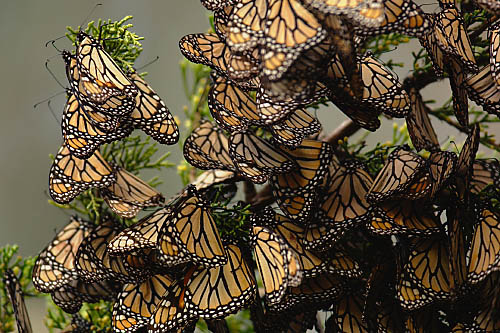|
|
"Santa Cruz Nature" |
| Most visitors to Santa Cruz are familiar with the boardwalk, the beach, and the surfing. Few visitors, however, are aware of the opportunities for wildlife viewing along the coast just beyond the main beach area. The Brown Pelican, once endangered by DDT and other pollutants, is omnipresent; Monarch Butterflies overwinter in several locations; grebes and other waterfowl are common in sheltered areas; and porpoises are commonly seen breaking the surface just beyond the kelp line. |
|
After six weeks of near constant rain, the San Francisco Bay Area and the California central coast got a respite and was basking in the sun. The air had turned cold, with near freezing temperatures, but the air was clear and still. A good time to load up the car and head out to shoot. This brisk January morning I decided to head down to Santa Cruz to photograph Brown Pelicans. Often when San Francisco is fogged in or overcast, the skies clear up somewhat north of Santa Cruz -- around Pigeon Point/Ano Nuevo. If the rains returned, I hoped the location would provide a buffer to allow me to shoot as long as possible. |
 |
|
There is something about the Brown Pelican that touches me deeply. Its appearance is primeval, its gait on land clumsy and comical, but its floating flight is a display of absolute, effortless grace. In the air, a pelican group exhibits comfort and confidence as it skims the wave tops on its way from one sheltered fishing location to another. I arrived at Santa Cruz right before the sun crested over the horizon. Out to sea was a large cloud bank working its way towards land. Just south of Natural Bridges State Beach is a series of smaller rock towers separated from the main cliff by narrow gaps. As I had expected, there were Brown Pelicans in breeding plumage on the towers. I located a tower that had a broad ledge across from it, brought down my tripod and the big Canon EF600 lens with the EOS D30 attached. |
 |
|
As it turned out, the pelicans were sufficiently accustomed to people and secure by the physical barrier imposed by the narrow gap that they didn't particularly mind my presence. At this location, a 400 would have worked just as well. The rock tower I selected had a taller rock behind it, giving me some freedom to choose my background: the other rock for a generally dark backdrop, or the ocean for a slate grey-blue. In addition, I could shoot birds stretching or landing on the rear rock. A couple of hours later the sun was sufficiently high that it was time for me to move on. Next stop: Natural Bridges State Beach. From this beach a rock arch carved out by the ocean is visible. There used to be three arches, but over the years two have collapsed due to erosion and now only one remains. While there are more archs and sea caves along the coast, this beach used to provide a view of a whole interconnected series. But I wasn't there to view the arches -- my mind was set on Monarch Butterflies. Certain years 35,000 butterflies overwinter in the eucalyptus grove just inland from the beach. As it turns out, this year there are only 2,000, although I learned from a volunteer docent that there are many more at Lighthouse Field, just a few minutes south, where they rest in a cypress tree. |
 |
| At Lighthouse Field I soon found the cypress, and it indeed had large clusters of butterflies. Being a cold morning, the Monarchs in the cypress were still and tightly clustered together. Monarchs need a minimum temperature of 55 degrees F to fly, and it certainly hadn't reached that level yet. So despite being late in the day, there were plenty of resting butterflies. Overhead, the clouds were moving in and the light was rapidly disappearing. With a sense of urgency, I pointed the Canon 600 on its gimbal tripod head up towards the branches and ran a series of "recipe" shots. I didn't feel I had the time to get too creative. |
 |
| My premonitions turned out to be correct... within a few minutes of setting up, the first drops fell and I decided to call it a day. Driving back to San Francisco in the rain, I thought about how I must have at least a few decent pelican shots and to add to my portfolio, as well as some introductory shots of a subject I hadn't explored before. I felt thankful to live in such a naturally beautiful and diverse place, and how nature provides a nearly endless bounty of wildlife for both eye and camera. |
|
|
| For Comments post in our News Group |